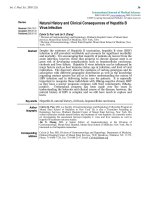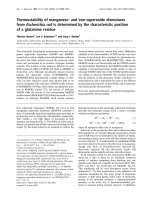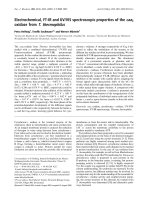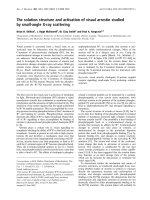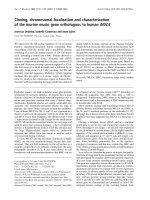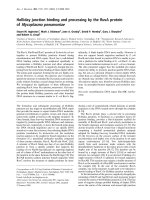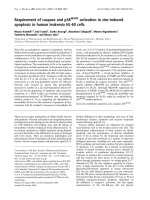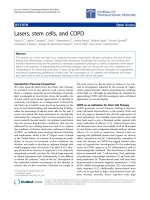Báo cáo y học: "Natural killer cells and autoimmunity" doc
Bạn đang xem bản rút gọn của tài liệu. Xem và tải ngay bản đầy đủ của tài liệu tại đây (123.12 KB, 7 trang )
8
AchR = acetylcholine receptor; CV = coxsackievirus; DC = dendritic cell; EAE = experimental autoimmune encephalomyelitis; EAMG = experimental
autoimmune myasthenia gravis; EAU = experimental autoimmune uveoretinitis; IFN-γ = interferon-γ; IL = interleukin; JRA = juvenile rheumatoid
arthritis; KIR = killer immunoglobulin-like receptor; MHC = major histocompatibility complex; MICA = MHC class I-related chain A; MS = multiple
sclerosis; NK = natural killer; RA = rheumatoid arthritis; SLE = systemic lupus erythematosus; Th = T helper cells.
Arthritis Research & Therapy Vol 6 No 1 French and Yokoyama
Natural killer cells
Natural killer (NK) cells are large, granular, bone marrow-
derived lymphocytes that do not express T or B cell recep-
tors [1]. In humans, these CD3-negative cells are
identified by the surface markers CD16 and CD56 and
comprise 5–15% of the peripheral blood mononuclear
cells in normal individuals [2]. Although they were initially
identified by their ability to lyse tumor cells without prior
sensitization, more recent work has demonstrated that
they have a crucial role in the initial defense against
pathogens and are particularly important in responding to
viral infections (reviewed in [3,4]).
NK cells are poised for a rapid response to infected or
transformed cells either by killing the abnormal cells or by
releasing immunomodulatory chemokines and cytokines
such as interferon-γ (IFN-γ). The chemokines and
cytokines released by NK cells influence the initiation and
development of the subsequent adaptive immune
response [5–9]. Clearly, NK cell functions must be care-
fully regulated to prevent damage to normal tissues or the
indiscriminate release of cytokines resulting in inappropri-
ate activation of the adaptive immune system.
NK cell responses result from the integration of signals
from both cytokine receptors and germline-encoded NK
cell inhibitory and activation receptors. NK cell receptors
include the murine C-type lectin-like receptors in the Ly49
family, the C-type lectin-like receptors shared by mouse
and human (for example NKR-P1, NKG2D and
CD94/NKG2A), the human immunoglobulin-like receptors
in the killer immunoglobulin-like receptor (KIR) family, and
the immunoglobulin-like receptors shared by both mouse
and human (for example 2B4) including the natural cyto-
toxicity receptor family (Nkp30, Nkp44 and Nkp46;
reviewed in [1,10–13]).
Although NK cells are prepared to kill abnormal cells and
rapidly release cytokines, they are normally restrained by
inhibitory receptors that recognize target-cell-expressed
MHC class I molecules and allow NK cells to survey
tissues for normal MHC class I expression (Fig. 1). When
MHC class I molecules are downregulated or absent, NK
cells are released from the inhibitory influence of these
receptors and kill target cells more efficiently (‘missing
self’ hypothesis) [14]. It has been proposed that NK cells
all express at least one inhibitory receptor that recognizes
Review
Natural killer cells and autoimmunity
Anthony R French
1
and Wayne M Yokoyama
2
1
Division of Pediatric Rheumatology, Department pf Pediatrics, Washington University School of Medicine, St Louis, MO, USA
2
Howard Hughes Medical Institute, Division of Rheumatology, Department of Medicine, Washington University School of Medicine, St Louis, MO, USA
Corresponding author: Wayne M Yokoyama (e-mail: )
Received: 5 Nov 2003 Accepted: 24 Nov 2003 Published: 9 Dec 2003
Arthritis Res Ther 2004, 6:8-14 (DOI 10.1186/ar1034)
© 2004 BioMed Central Ltd (Print ISSN 1478-6354; Online ISSN 1478-6362)
Abstract
Autoimmune diseases are often characterized as clinical syndromes caused by the inappropriate
activation of T or B cells resulting in systemic or organ-specific damage. However, studies support a
role for the innate immune system, and in particular natural killer (NK) cells, in stimulating or
suppressing autoimmunity. This review focuses on recent research elucidating a potential
immunoregulatory role for NK cells in modulating T and B cell-mediated autoimmunity.
Keywords: autoimmunity, immunoregulation, natural killer cells
9
Available online />self MHC to provide NK cell tolerance and to prevent
inappropriate NK cell responses directed at self [15,16].
However, release from inhibitory receptor effects does not
automatically lead to NK cell activation against cellular
targets. NK cells also express different combinations of
various activation receptors, allowing them to respond to
ligands on potential target cells [17–20]. The ligands for
activation receptors are often closely related to the ligands
for inhibitory receptors. In other cases, the activation
receptor ligands may be upregulated in response to stress
or infection, as illustrated by the upregulation of the
NKG2D ligand MHC class I-related chain A (MICA) during
infection [21–23].
NK cells can also respond directly to cytokines such as
interleukin (IL)-12 and IL-18 that stimulate their production
of other cytokines, including IFN-γ (not shown in Fig. 1).
Such cytokine-mediated responses are generally not regu-
lated by MHC class I expression, although MHC class I
expression does regulate target-cell-stimulated cytokine
release (Fig. 1).
Observations of NK cell abnormalities in
human autoimmune diseases
Since the early 1980s, many studies have documented
decreased NK cell numbers and impairment of NK cell
function in the peripheral blood of patients with autoim-
mune diseases such as multiple sclerosis (MS), systemic
lupus erythematosus (SLE), Sjögren’s syndrome, rheuma-
toid arthritis (RA), and type I diabetes (reviewed in
[24–26]). However, some of the older reports did not dis-
tinguish between NK cells and NKT cells, a potential
immunoregulatory subpopulation of T cells that are also
able to rapidly release large amounts of cytokines. Better
discrimination between these two populations has shown
that in addition to the decreased NK cell numbers found in
many autoimmune diseases, NKT cells are decreased in
RA and psoriasis [27,28], but this topic is beyond the
scope of this review.
More recent reports have also shown an association
between NK cell deficits and autoimmune thyroid disease
[29,30] and psoriasis [31] as well as several pediatric
rheumatologic diseases including juvenile dermatomyositis
[32] or SLE [33]. Low NK cell numbers have also been
found in patients with systemic-onset juvenile rheumatoid
arthritis (JRA) [34], and decreased NK cell function has
been documented in systemic-onset JRA patients with
macrophage activation syndrome or hemophagocytic lym-
phohistiocytosis [35–37].
Although there is substantial evidence correlating
decreased NK cell numbers and function with autoimmune
diseases, it is not clear whether the reported NK cell alter-
ations occur secondarily to the disease and its treatments
or are primary defects involved in the disease pathogen-
esis. However, recent studies have documented NK cell
defects in treatment-naïve patients before overt progres-
sion to disease or at the time of diagnosis, demonstrating
that the defects are not solely treatment-related or the
result of chronic inflammation from long-standing disease
[32,33]. In addition, a temporal correlation has been iden-
tified between NK cell numbers or activity and periods of
disease progression or remission in MS and SLE, sug-
gesting that NK cells may play an immunoregulatory role in
disease pathology [38–43].
The correlation of decreased NK cell numbers and/or
function with autoimmune diseases raises the possibility
that autoimmunity may arise from NK cell deficiencies.
However, such conclusions must be tempered by the fact
that reports of NK cell defects in patients with autoim-
mune diseases have been based almost exclusively on
studies of peripheral blood samples, which would not dis-
Figure 1
Natural killer (NK) cell activation is controlled by the integration of
signals from activation and inhibitory receptors. (a) Inhibitory NK cell
receptors recognize self MHC class I and restrain NK cell activation.
(b) When unimpeded by the inhibitory receptors, binding of NK cell
activation receptors to their ligands on target cells results in NK cell
stimulation. In the absence or downregulation of self MHC class I on
the target cells, these stimulatory signals are no longer suppressed,
resulting in NK cell responses including cytokine production and
granule release leading to cytotoxicity. Note that this model indicates
that NK cells do not kill by default; that is, when MHC class I inhibition
is absent, the NK cell must still be stimulated through activation
receptors. Moreover, whether or not an individual NK cell is activated
by a target is determined by this complex balance of receptors with
opposing function and expression of the corresponding ligands. In
general, however, inhibition dominates over activation. Finally, NK cells
can be directly stimulated by cytokines such as interleukin-12 that
trigger the production of other cytokines by NK cells (not shown).
These direct cytokine-mediated responses are not affected by MHC
class I expression.
Target
NK
+
Activation receptor
Inhibitory receptor
(a)
(b)
Target
NK
+
MHC class I
Activation receptor
ligand
Granule release (Cytotoxicity)
Cytokine production
10
Arthritis Research & Therapy Vol 6 No 1 French and Yokoyama
tinguish between true deficits and sequestration of NK
cells in target tissues. In addition, the clinical course of
patients with selective, complete NK cell deficiencies has
been dominated by overwhelming infections, often from
herpesviruses, and not by autoimmune syndromes
[44–46]. In contrast, NK cell lymphocytosis and leukemia
are associated with autoimmune syndromes, such as vas-
culitis and RA [47–49], suggesting that peripheral-blood
NK cell defects in systemic autoimmune syndromes may
be due to the sequestration of NK cells in target tissues.
Alterations in KIR expression on NK cells (and/or on T cells)
have also been associated with autoimmune diseases such
as Behcet’s disease, type I diabetes, and psoriasis [50–52].
In addition, aberrant expression of NK cell receptors on sub-
populations of CD4
+
T cells has been observed in patients
with RA [53–56]. Skewed KIR receptor repertoires may
potentially lower the threshold for NK cell or T cell activation
when activating forms of the immunoglobulin-like receptors
(KARs) are present either in the absence of their corre-
sponding inhibitory KIRs or in the absence of the HLA
ligands for the inhibitory KIRs [50–53,55].
Abnormal expression of another NK cell activation receptor,
NKG2D, has also been observed on a fraction of CD4
+
T cells in patients with RA [57]. Furthermore, expression of
MICA, an inducible ligand for the NKG2D [58], has also
been identified in the synovium of patients with RA, sug-
gesting that the abnormal expression of MICA in the context
of upregulation of NKG2D on CD4
+
T cells in patients with
RA may result in this subpopulation of CD4
+
T cells receiv-
ing persistent co-stimulation [57]. In addition to potentially
prolonging T-cell activation, the aberrant expression of
MICA may also be involved in modulating the responses of
NK cells in the inflamed synovium.
Indeed, NK cells comprise a significant fraction of the lym-
phocytes found in the synovial fluid of patients with RA
(8–16% of lymphocytes) and can be detected in the joint
at an early stage in the disease course [59]. Interestingly,
most of the NK cells in the synovial fluid of patients with
established RA are CD56
bright
, with elevated expression of
both CD94 and NKG2A and decreased expression of
KIRs and CD16 [60,61]. The CD56
bright
subpopulation of
NK cells is also found in the blood of patients with RA and
normal controls but at much lower frequencies (typically
10% of NK cells). Although originally thought to be imma-
ture NK cells, evidence now supports the hypothesis that
CD56
bright
NK cells are a separate subpopulation that
produce high levels of cytokines and may potentially play a
role in immunoregulation [62,63]. The NK cells within the
synovium also have an upregulated expression of several
chemokine receptors and adhesion molecules that may
participate in preferential recruitment into the synovium
[60]. It is proposed that the unusual enrichment of
CD56
bright
NK cells may have a role in the initiation and/or
perpetuation of dysregulated production of proinflamma-
tory cytokines in the synovium of patients with RA [60,61].
It is also possible that aberrant expression of MICA in the
inflamed synovium [57] is involved in modulating the
responses of this subset of NK cells, resulting in the dys-
regulated production of proinflammatory cytokines rather
than in immunoregulation.
Most of the evidence from human autoimmune diseases
suggests that NK cells may be involved in immunoregula-
tion and/or autoimmune disease pathogenesis. However,
because it is difficult to determine potential mechanistic
roles of NK cells in these diseases and to rule out epiphe-
nomena in humans, we will now shift our focus to mouse
models of autoimmunity.
Insight into the role of NK cells in
autoimmunity from mouse models of
autoimmune diseases
The role of NK cells in autoimmune responses has been
examined in several murine models of autoimmune dis-
eases (reviewed in [25,26]). The evidence from these
studies (discussed below) suggests that NK cells can
affect the development of autoimmunity through several
mechanisms, including suppressing viral infections and
potential subsequent autoimmune responses, modulating
autoreactive responses of other immune cells, or, as effec-
tor cells, directly mediating tissue damage (Fig. 2). Differ-
ent NK cell responses in these models presumably result
from alterations in the balance between inhibitory and
stimulatory signals mediated through the interactions of
NK cell receptors and their ligands. The expression levels
of ligands for both inhibitory and activation NK cell recep-
tors in target tissues as well as the immediate cytokine
milieu modulate the NK cell activation threshold, allowing
different NK cell responses that could potentially suppress
or augment autoimmunity.
Viral infections have been implicated in the pathogenesis
of several autoimmune diseases due to molecular mimicry
or polyclonal immune activation [64]. It is well established
that NK cells have a crucial role in the initial defense
against viral infections [3,4]. It is therefore not surprising
that several investigators have attributed the impact of rel-
ative deficiencies of NK cell numbers or function seen in
many autoimmune diseases to a decreased ability to
respond to viral infections.
Results from mouse models show a role for NK cells in
suppressing autoimmune responses after viral infections
(Fig. 2a). For example, NK cells are important in preventing
encephalitis in a murine model of MS induced by Theiler’s
murine encephalitis virus [65]. Depletion of NK cells in
resistant mice resulted in the development of diffuse
encephalitis and meningitis early in the post-infection
period [65]. NK cells are also thought to prevent coxsack-
11
ievirus B3 (CVB3)-induced myocarditis by limiting viral
replication and thus preventing prolonged immune activa-
tion and minimizing tissue damage with exposure of self
antigens. Infection with either CVB3 or murine
cytomegalovirus resulted in chronic myocarditis in suscep-
tible strains of mice, accompanied by the development of
autoantibodies against cardiac myosin [66]. Depletion of
NK cells before infection with CVB3 rendered resistant
strains of mice as sensitive to the development of
myocarditis as susceptible strains of mice [66]. Thus, NK
cells may have a role in suppressing autoimmunity after
viral infections by effectively limiting viral replication and
subsequent tissue destruction.
Evidence from murine models also supports an
immunoregulatory role for NK cells in modulating other
immune cell responses (Fig. 2b). The development of
autoimmunity in C57BL/6lpr mice, which have a defect in
Fas, a gene encoding a tumor necrosis factor receptor
superfamily member involved in inducing apoptosis, is
temporally related to an age-dependent loss of NK and
NKT cells. Furthermore, antibody-mediated NK cell deple-
tion in these mice enhanced the development of autoanti-
body-secreting B cells, whereas the adoptive transfer of
NK cells delayed the onset of autoantibody production
[67]. Studies in vitro have shown that rat NK cells can
inhibit autoreactive T cell cytokine production and prolifer-
ation [68]. Indeed, depletion of NK cells worsened colitis
in a CD4
+
T cell transfer model in mice, demonstrating an
immunoregulatory role for NK cells [69]. Several investiga-
tors have reported similar findings in experimental autoim-
mune encephalomyelitis (EAE), a Th1-mediated mouse
model of MS [70,71]. Depletion of NK cells before immu-
nization of sensitive mice with myelin oligodendrocyte gly-
coprotein (MOG
35–55
) peptide resulted in clinically more
severe, relapsing EAE [70]. Depletion of NK cells also
resulted in more severe disease after passive transfer of
an EAE-inducing CD4
+
T cell line, showing that NK cells
are not only involved in the initiation of EAE but can inhibit
effector T cells [70]. NK cell depletion in rats before immu-
nization with myelin basic protein also exacerbated the
clinical features of EAE and increased mortality [71].
However, these results conflict with a third study, which
reported that NK cell depletion resulted in less severe clin-
ical scores [72]. Overall, NK cells appear to participate in
regulating T and B cell-mediated autoimmune responses.
Less information is available on how NK cells perform this
potential immunoregulatory role. It is possible that this role
is mediated directly by the release of immunomodulatory
cytokines and chemokines involved in lymphocyte recruit-
ment, activation, and suppression, such as IFN-γ and
transforming growth factor-β. However, NK cell-derived
cytokines and chemokines may act indirectly by inducing
cytokine production in other cells, activating macro-
phages, or supporting the maturation of dendritic cells
(DCs). Indeed, bidirectional interactions between NK cells
and other components of the innate immune system such
as DCs and NKT cells have been reported ([73–75];
reviewed in [9,76]). It is also possible that the immunoreg-
ulatory role of NK cells is mediated by the killing of auto-
reactive lymphocytes or immature DCs by NK cells. The
immunoregulatory role of NK cells in suppressing colitis in
a murine CD4
+
T cell transfer model was found to be
dependent on perforin, suggesting that the NK cells were
directly killing autoreactive T cells or some other intermediate
effector cells such as DCs [69]. In addition, several studies
have shown that NK cells are potentially able to influence the
subsequent adaptive immune response by lysing immature
DCs [74,75] or developing T cells [77]. Therefore, it appears
that NK cells may employ several different mechanisms to
regulate the responses of other immune cells and thereby
affect the development of autoimmunity.
Murine models of other autoimmune diseases suggest
that NK cells may also participate in the initiation of
Available online />Figure 2
Murine models show that natural killer (NK) cells affect autoimmunity
through several potential mechanisms. (a) NK cells limit viral-induced
tissue damage by directly killing virally infected cells or by releasing
cytokines that can suppress viral propagation either directly or
indirectly by activating other cells such as macrophages. Defective NK
cell responses to viral infections may result in autoimmunity in
genetically predisposed strains of mice as a result of uncontrolled
infection leading to increased tissue destruction, with accompanying
exposure of self antigens. (b) NK cells participate in the
immunoregulation of other immune cells. Control of autoreactive T and
B cells by NK cells may be mediated directly through the release of
cytokines and chemokines or indirectly through bidirectional
interactions with other components of the innate immune system such
as dendritic cells (DCs). In addition, it is possible that NK cells may kill
autoreactive lymphocytes or inappropriately activated immature DCs.
(c) NK cells could potentially mediate an autoimmune response by
inappropriately killing normal tissues.
NK
Infected target
Cytokine release
Cytotoxicity
NK
Cytokine release
Cytotoxicity
NK
Normal tissue
Cytotoxicity
(a)
(b)
(c)
Immune cell
(T, B, DC, etc.)
Uncontrolled infection
Regulate other
immune cells
Tissue damage
12
autoimmunity through interactions with autoreactive T and
B cells. Experimental autoimmune myasthenia gravis
(EAMG) is an antibody-mediated autoimmune disease in
which autoantibodies against the acetylcholine receptor
(AchR) in neuromuscular junctions are stimulated in sus-
ceptible mice by repeated immunizations with Torpedo
AChR in adjuvant. Depletion of NK cells before immuniza-
tion resulted in significantly delayed onset and decreased
severity of EAMG with decreased anti-AChR antibody pro-
duction [78]. Interestingly, NK cell depletion after the initial
immunization had no impact on the development of
EAMG. In a mouse model of asthma, initial immunization
with ovalbumin in adjuvant followed by repeated daily
exposure to aerosolized ovalbumin resulted in CD4
+
T cell-dependent pulmonary eosinophilic inflammation and
systemic IgE production, consistent with a Th2 immune
response [79]. Depletion of NK cells before the initial
immunization but not later during the challenge period
resulted in a diminished infiltration of pulmonary
eosinophils and CD3
+
T cells as well as a decreased sys-
temic production of IgE, suggesting a role for NK cells in
promoting allergen-induced airway inflammation [79].
Interestingly, the temporal impact of NK depletion
observed in these models has also been reported in an
EAE model in which the depletion of NK cells after the
primary immunization did not impact development of EAE
[72]. These results suggest that NK cells may be most
influential at the initiation of the autoimmune response.
In addition to potential immunoregulatory roles for NK cells
in autoimmunity, NK cell-mediated cytotoxicity may result
directly in significant organ-specific damage (Fig. 2c).
Several groups have shown that activated NK cells can
lyse autologous neurons in vitro, suggesting that NK cell
cytotoxity may have a role in EAE [80,81]. NK cells have
also been implicated in the selective neuronal death in the
superior cervical ganglia of rats treated with guanethidine
[82]. Recent experiments have shown that NK cells can
kill syngeneic dorsal root ganglia neurons by a perforin-
dependent mechanism [83]. Interestingly, it was shown
that this response was mediated by NKG2D recognition
of a ligand on dorsal root ganglia neurons that was not
expressed on resistant central nervous system-derived
neurons [83]. NK cell-mediated killing of syngeneic
neurons expressing an NK cell activation receptor ligand
supports the hypothesis that inappropriate killing of self
tissues by NK cells may reflect a loss of NK cell ‘tolerance’
occurring in tissues that have inappropriately downregu-
lated MHC class I ligands for NK cell inhibitory receptors
or that have aberrant expression of ligands for NK cell acti-
vation receptors or expression of these ligands in tissues
that are normally isolated from NK cells.
NK cells appear to participate in mediating organ-specific
damage in several murine models of autoimmunity. Experi-
mental autoimmune uveoretinitis (EAU) is induced by
immunizing sensitive strains of mice with ocular autoanti-
gens. Depletion of NK cells before immunization resulted
in significantly less severe EAU, demonstrating that NK
cells participate in the development of EAU, either by
directly mediating cellular damage or by supporting rather
than suppressing autoreactive T cells [84]. A murine
model of autoimmune-mediated diabetes after viral infec-
tion with CVB4 provides another example of organ-spe-
cific, NK cell-mediated damage [85]. In this model, mice
whose pancreatic beta cells express a transgene for the
suppressor of cytokine signaling (SOCS-1), an inhibitor of
interferon signaling, develop diabetes soon after CVB4
infection. However, depletion of NK cells before infection
with CVB4 prevented the development of diabetes, imply-
ing that NK cells contributed to the destruction of the
infected pancreatic beta cells, although no direct evidence
was presented to show the involvement of NK cell-medi-
ated cytotoxicity [85]. Therefore, in spite of in vitro data
suggesting that NK cell-mediated cytotoxicity may result in
organ-specific autoimmunity, more direct in vivo experi-
mental evidence in murine models is needed to support
this hypothesis.
Conclusions
There is strong evidence that the innate immune system,
and in particular NK cells, influence subsequent adaptive
immune responses. By virtue of their ability to rapidly kill
abnormal cells and produce cytokines and chemokines,
NK cells are positioned for a key role in regulating autoim-
mune responses. The results summarized in this review
demonstrate that NK cells are involved in modulating
responses to self antigens and that in some circum-
stances NK cells can either suppress or augment autoim-
munity, directly or indirectly. The associations found in
humans and the empirical evidence from murine models
suggest that further research into the immunmodulatory
role of NK cells in autoimmunity is warranted and is likely
to provide new insights into the pathogenesis of autoim-
mune disorders.
Competing interests
None declared.
References
1. Yokoyama WM: Natural killer cell receptors. Curr Opin Immunol
1998, 10:298-305.
2. Seaman WE: Natural killer cells and natural killer T cells.
Arthritis Rheum 2000, 43:1204-1217.
3. Biron CA, Nguyen KB, Pien GC, Cousens LP, Salazar-Mather TP:
Natural killer cells in antiviral defense: function and regulation
by innate cytokines. Annu Rev Immunol 1999, 17:189-220.
4. French AR, Yokoyama WM: Natural killer cells and viral infec-
tions. Curr Opin Immunol 2003, 15:45-51.
5. Horwitz DA, Gray JD, Ohtsuka K, Hirokawa M, Takahashi T: The
immunoregulatory effects of NK cells – the role of TGF-
ββ
and
implications for autoimmunity. Immunol Today 1997, 18:538-
542.
6. Fearon DT, Locksley RM: The instructive role of innate immu-
nity in the acquired immune response. Science 1996, 272:50-
53.
Arthritis Research & Therapy Vol 6 No 1 French and Yokoyama
13
7. Kos FJ: Regulation of adaptive immunity by natural killer cells.
Immunol Res 1998, 17:303-312.
8. Su HC, Nguyen KB, Salazar-Mather TP, Ruzek MC, Dalod MY,
Biron CA: NK cell functions restrain T cell responses during
viral infections. Eur J Immunol 2001, 31:3048-3055.
9. Zitvogel L: Dendritic and natural killer cells cooperate in the
control/switch of innate immunity. J Exp Med 2002, 195:F9-
F14.
10. Lanier LL: NK cell receptors. Annu Rev Immunol 1998, 16:359-
393.
11. Campbell KS, Colonna M: Human natural killer cell receptors
and signal transduction. Int Rev Immunol 2001, 20:333-370.
12. Moretta L, Biassoni R, Bottino C, Cantoni C, Pende D, Mingari
MC, Moretta A: Human NK cells and their receptors. Microbes
Infect 2002, 4:1539-1544.
13. Yokoyama WM, Plougastel BF: Immune functions encoded by
the natural killer gene complex. Nat Rev Immunol 2003, 3:304-
316.
14. Ljunggren HG, Karre K: In search of the ‘missing self’: MHC
molecules and NK cell recognition. Immunol Today 1990, 11:
237-244.
15. Raulet DH: Development and tolerance of natural killer cells.
Curr Opin Immunol 1999, 11:129-134.
16. Raulet DH, Vance RE, McMahon CW: Regulation of the natural
killer cell receptor repertoire. Annu Rev Immunol 2001, 19:291-
330.
17. Lanier LL: On guard – activating NK cell receptors. Nat
Immunol 2001, 2:23-27.
18. Diefenbach A, Raulet DH: Strategies for target cell recognition
by natural killer cells. Immunol Rev 2001, 181:170-184.
19. Moretta A, Bottino C, Vitale M, Pende D, Cantoni C, Mingari MC,
Biassoni R, Moretta L: Activating receptors and coreceptors
involved in human natural killer cell-mediated cytolysis. Annu
Rev Immunol 2001, 19:197-223.
20. Smith HR, Idris AH, Yokoyama WM: Murine natural killer cell
activation receptors. Immunol Rev 2001, 181:115-125.
21. Groh V, Rhinehart R, Randolph-Habecker J, Topp MS, Riddell SR,
Spies T: Costimulation of CD8
ααββ
T cells by NKG2D via
engagement by MIC induced on virus-infected cells. Nat
Immunol 2001, 2:255-260.
22. Das H, Groh V, Kuijl C, Sugita M, Morita CT, Spies T, Bukowski
JF: MICA engagement by human V
γγ
2V
δδ
2 T cells enhances
their antigen-dependent effector function. Immunity 2001, 15:
83-93.
23. Tieng V, Le Bouguenec C, du Merle L, Bertheau P, Desreumaux
P, Janin A, Charron D, Toubert A: Binding of Escherichia coli
adhesin AfaE to CD55 triggers cell-surface expression of the
MHC class I-related molecule MICA. Proc Natl Acad Sci USA
2002, 99:2977-2982.
24. Grunebaum E, Malatzky-Goshen E, Shoenfeld Y: Natural killer
cells and autoimmunity. Immunol Res 1989, 8:292-304.
25. Flodstrom M, Shi FD, Sarvetnick N, Ljunggren HG: The natural
killer cell – friend or foe in autoimmune disease? Scand J
Immunol 2002, 55:432-441.
26. Baxter AG, Smyth MJ: The role of NK cells in autoimmune
disease. Autoimmunity 2002, 35:1-14.
27. Yanagihara Y, Shiozawa K, Takai M, Kyogoku M, Shiozawa S:
Natural killer (NK) T cells are significantly decreased in the
peripheral blood of patients with rheumatoid arthritis (RA).
Clin Exp Immunol 1999, 118:131-136.
28. Koreck A, Suranyi A, Szony BJ, Farkas A, Bata-Csorgo Z, Kemeny
L, Dobozy A: CD3+CD56+ NK T cells are significantly
decreased in the peripheral blood of patients with psoriasis.
Clin Exp Immunol 2002, 127:176-182.
29. Bossowski A, Urban M, Stasiak-Barmuta A: Analysis of circulat-
ing T gamma/delta lymphocytes and CD16/56 cell popula-
tions in children and adolescents with Graves’ disease.
Pediatr Res 2003, 54:425-429.
30. Ciampolillo A, Guastamacchia E, Amati L, Magrone T, Munno I,
Jirillo E, Triggiani V, Fallacara R, Tafaro E: Modifications of the
immune responsiveness in patients with autoimmune thy-
roiditis: evidence for a systemic immune alteration. Curr
Pharm Des 2003, 9:1946-1950.
31. Cameron AL, Kirby B, Griffiths CE: Circulating natural killer
cells in psoriasis. Br J Dermatol 2003, 149:160-164.
32. O’Gorman M, Smith R, Garrison A, Shamiyeh E, Pachman L: Lym-
phocyte subsets in peripheral blood from newly diagnosed,
untreated patients with juvenile dermatomyositis (JDM) are
associated with disease activity scores (DAS). Arthritis Rheum
2002, 46(suppl 9):S490.
33. Yabuhara A, Yang FC, Nakazawa T, Iwasaki Y, Mori T, Koike K,
Kawai H, Komiyama A: A killing defect of natural killer cells as
an underlying immunologic abnormality in childhood systemic
lupus erythematosus. J Rheumatol 1996, 23:171-177.
34. Wouters CH, Ceuppens JL, Stevens EA: Different circulating
lymphocyte profiles in patients with different subtypes of
juvenile idiopathic arthritis. Clin Exp Rheumatol 2002, 20:239-
248.
35. Wulffraat NM, Rijkers GT, Elst E, Brooimans R, Kuis W: Reduced
perforin expression in systemic juvenile idiopathic arthritis is
restored by autologous stem-cell transplantation. Rheumatol-
ogy (Oxford) 2003, 42:375-379.
36. Imashuku S, Hyakuna N, Funabiki T, Ikuta K, Sako M, Iwai A,
Fukushima T, Kataoka S, Yabe M, Muramatsu K, Kohdera U, Naka-
date H, Kitazawa K, Toyoda Y, Ishii E: Low natural killer activity
and central nervous system disease as a high-risk prognostic
indicator in young patients with hemophagocytic lymphohisti-
ocytosis. Cancer 2002, 94:3023-3031.
37. Grom AA, Villanueva J, Lee S, Goldmuntz EA, Passo MH, Fil-
ipovich A: Natural killer cell dysfunction in patients with sys-
temic-onset juvenile rheumatoid arthritis and macrophage
activation syndrome. J Pediatr 2003, 142:292-296.
38. Erkeller-Yusel F, Hulstaart F, Hannet I, Isenberg D, Lydyard P:
Lymphocyte subsets in a large cohort of patients with sys-
temic lupus erythematosus. Lupus 1993, 2:227-231.
39. Erkeller-Yuksel FM, Lydyard PM, Isenberg DA: Lack of NK cells
in lupus patients with renal involvement. Lupus 1997, 6:708-
712.
40. Munschauer FE, Hartrich LA, Stewart CC, Jacobs L: Circulating
natural killer cells but not cytotoxic T lymphocytes are
reduced in patients with active relapsing multiple sclerosis
and little clinical disability as compared to controls. J Neuroim-
munol 1995, 62:177-181.
41. Kastrukoff LF, Morgan NG, Zecchini D, White R, Petkau AJ, Satoh
J, Paty DW: A role for natural killer cells in the immunopatho-
genesis of multiple sclerosis. J Neuroimmunol 1998, 86:123-
133.
42. Riccieri V, Spadaro A, Parisi G, Taccari E, Moretti T, Bernardini G,
Favaroni M, Strom R: Down-regulation of natural killer cells
and of gamma/delta T cells in systemic lupus erythematosus.
Does it correlate to autoimmunity and to laboratory indices of
disease activity? Lupus 2000, 9:333-337.
43. Takahashi K, Miyake S, Kondo T, Terao K, Hatakenaka M,
Hashimoto S, Yamamura T: Natural killer type 2 bias in remis-
sion of multiple sclerosis. J Clin Invest 2001, 107:R23-R29.
44. Biron CA, Byron KS, Sullivan JL: Severe herpesvirus infections
in an adolescent without natural killer cells. N Engl J Med
1989, 320:1731-1735.
45. Jawahar S, Moody C, Chan M, Finberg R, Geha R, Chatila T:
Natural Killer (NK) cell deficiency associated with an epitope-
deficient Fc receptor type IIIA (CD16-II). Clin Exp Immunol
1996, 103:408-413.
46. Orange JS: Human natural killer cell deficiencies and suscep-
tibility to infection. Microbes Infect 2002, 4:1545-1558.
47. Lamy T, Loughran TP Jr: Clinical features of large granular lym-
phocyte leukemia. Semin Hematol 2003, 40:185-195.
48. Tefferi A, Li CY, Witzig TE, Dhodapkar MV, Okuno SH, Phyliky RL:
Chronic natural killer cell lymphocytosis: a descriptive clinical
study. Blood 1994, 84:2721-2725.
49. Rabbani GR, Phyliky RL, Tefferi A: A long-term study of patients
with chronic natural killer cell lymphocytosis. Br J Haematol
1999, 106:960-966.
50. Martin MP, Nelson G, Lee JH, Pellett F, Gao X, Wade J, Wilson
MJ, Trowsdale J, Gladman D, Carrington M: Cutting edge: sus-
ceptibility to psoriatic arthritis: influence of activating killer Ig-
like receptor genes in the absence of specific HLA-C alleles. J
Immunol 2002, 169:2818-2822.
51. van der Slik AR, Koeleman BP, Verduijn W, Bruining GJ, Roep
BO, Giphart MJ: KIR in type 1 diabetes: disparate distribution
of activating and inhibitory natural killer cell receptors in
patients versus HLA-matched control subjects. Diabetes 2003,
52:2639-2642.
52. Takeno M, Shimoyama Y, Kashiwakura JI, Nagafuchi H, Sakane T,
Suzuki N: Abnormal killer inhibitory receptor expression on
Available online />14
natural killer cells in patients with Behcet’s disease. Rheuma-
tol Int 2003 [epub ahead of print].
53. Namekawa T, Snyder MR, Yen JH, Goehring BE, Leibson PJ,
Weyand CM, Goronzy JJ: Killer cell activating receptors func-
tion as costimulatory molecules on CD4+CD28null T cells
clonally expanded in rheumatoid arthritis. J Immunol 2000,
165:1138-1145.
54. Warrington KJ, Takemura S, Goronzy JJ, Weyand CM:
CD4+,CD28- T cells in rheumatoid arthritis patients combine
features of the innate and adaptive immune systems. Arthritis
Rheum 2001, 44:13-20.
55. Yen JH, Moore BE, Nakajima T, Scholl D, Schaid DJ, Weyand CM,
Goronzy JJ: Major histocompatibility complex class I-recogniz-
ing receptors are disease risk genes in rheumatoid arthritis. J
Exp Med 2001, 193:1159-1168.
56. Snyder MR, Lucas M, Vivier E, Weyand CM, Goronzy JJ: Selec-
tive activation of the c-Jun NH
2
-terminal protein kinase signal-
ing pathway by stimulatory KIR in the absence of KARAP/
DAP12 in CD4
+
T cells. J Exp Med 2003, 197:437-449.
57. Groh V, Bruhl A, El-Gabalawy H, Nelson JL, Spies T: Stimulation
of T cell autoreactivity by anomalous expression of NKG2D
and its MIC ligands in rheumatoid arthritis. Proc Natl Acad Sci
USA 2003, 100:9452-9457.
58. Bauer S, Groh V, Wu J, Steinle A, Phillips JH, Lanier LL, Spies T:
Activation of NK cells and T cells by NKG2D, a receptor for
stress-inducible MICA. Science 1999, 285:727-729.
59. Tak PP, Kummer JA, Hack CE, Daha MR, Smeets TJ, Erkelens
GW, Meinders AE, Kluin PM, Breedveld FC: Granzyme-positive
cytotoxic cells are specifically increased in early rheumatoid
synovial tissue. Arthritis Rheum 1994, 37:1735-1743.
60. Dalbeth N, Callan MF: A subset of natural killer cells is greatly
expanded within inflamed joints. Arthritis Rheum 2002, 46:
1763-1772.
61. Pridgeon C, Lennon GP, Pazmany L, Thompson RN, Christmas SE,
Moots RJ: Natural killer cells in the synovial fluid of rheumatoid
arthritis patients exhibit a CD56
bright
,CD94
bright
,CD158
negative
phenotype. Rheumatology (Oxford) 2003, 42:870-878.
62. Cooper MA, Fehniger TA, Turner SC, Chen KS, Ghaheri BA,
Ghayur T, Carson WE, Caligiuri MA: Human natural killer cells:
a unique innate immunoregulatory role for the CD56
bright
subset. Blood 2001, 97:3146-3151.
63. Farag SS, VanDeusen JB, Fehniger TA, Caligiuri MA: Biology and
clinical impact of human natural killer cells. Int J Hematol
2003, 78:7-17.
64. Fujinami RS: Can virus infections trigger autoimmune
disease? J Autoimmun 2001, 16:229-234.
65. Paya CV, Patick AK, Leibson PJ, Rodriguez M: Role of natural
killer cells as immune effectors in encephalitis and demyeli-
nation induced by Theiler’s virus. J Immunol 1989, 143:95-102.
66. Fairweather D, Kaya Z, Shellam GR, Lawson CM, Rose NR: From
infection to autoimmunity. J Autoimmun 2001, 16:175-186.
67. Takeda K, Dennert G: The development of autoimmunity in
C57BL/6 lpr mice correlates with the disappearance of
natural killer type 1-positive cells: evidence for their suppres-
sive action on bone marrow stem cell proliferation, B cell
immunoglobulin secretion, and autoimmune symptoms. J Exp
Med 1993, 177:155-164.
68. Smeltz RB, Wolf NA, Swanborg RH: Inhibition of autoimmune T
cell responses in the DA rat by bone marrow-derived NK cells
in vitro: implications for autoimmunity. J Immunol 1999, 163:
1390-1397.
69. Fort MM, Leach MW, Rennick DM: A role for NK cells as regula-
tors of CD4+ T cells in a transfer model of colitis. J Immunol
1998, 161:3256-3261.
70. Zhang B, Yamamura T, Kondo T, Fujiwara M, Tabira T: Regulation
of experimental autoimmune encephalomyelitis by natural
killer (NK) cells. J Exp Med 1997, 186:1677-1687.
71. Matsumoto Y, Kohyama K, Aikawa Y, Shin T, Kawazoe Y, Suzuki
Y, Tanuma N: Role of natural killer cells and TCR gamma delta
T cells in acute autoimmune encephalomyelitis. Eur J Immunol
1998, 28:1681-1688.
72. Shi FD, Takeda K, Akira S, Sarvetnick N, Ljunggren HG: IL-18
directs autoreactive T cells and promotes autodestruction in
the central nervous system via induction of IFN-gamma by NK
cells. J Immunol 2000, 165:3099-3104.
73. Carnaud C, Lee D, Donnars O, Park SH, Beavis A, Koezuka Y,
Bendelac A: Cutting edge: cross-talk between cells of the
innate immune system: NKT cells rapidly activate NK cells. J
Immunol 1999, 163:4647-4650.
74. Gerosa F, Baldani-Guerra B, Nisii C, Marchesini V, Carra G,
Trinchieri G: Reciprocal activating interaction between natural
killer cells and dendritic cells. J Exp Med 2002, 195:327-333.
75. Piccioli D, Sbrana S, Melandri E, Valiante NM: Contact-depen-
dent stimulation and inhibition of dendritic cells by natural
killer cells. J Exp Med 2002, 195:335-341.
76. Moretta A: Natural killer cells and dendritic cells: rendezvous
in abused tissues. Nat Rev Immunol 2002, 2:957-964.
77. Schott E, Bonasio R, Ploegh HL: Elimination in vivo of develop-
ing T cells by natural killer cells. J Exp Med 2003, 198:1213-
1224.
78. Shi FD, Wang HB, Li H, Hong S, Taniguchi M, Link H, Van Kaer L,
Ljunggren HG: Natural killer cells determine the outcome of B
cell-mediated autoimmunity. Nat Immunol 2000, 1:245-251.
79. Korsgren M, Persson CG, Sundler F, Bjerke T, Hansson T, Cham-
bers BJ, Hong S, Van Kaer L, Ljunggren HG, Korsgren O: Natural
killer cells determine the development of allergen-induced
eosinophilic airway inflammation in mice. J Exp Med 1999,
189:553-562.
80. Backstrom E, Chambers BJ, Kristensson K, Ljunggren HG: Direct
NK cell-mediated lysis of syngenic dorsal root ganglia
neurons in vitro. J Immunol 2000, 165:4895-4900.
81. Morse RH, Seguin R, McCrea EL, Antel JP: NK cell-mediated
lysis of autologous human oligodendrocytes. J Neuroimmunol
2001, 116:107-115.
82. Hickey WF, Ueno K, Hiserodt JC, Schmidt RE: Exogenously-
induced, natural killer cell-mediated neuronal killing: a novel
pathogenetic mechanism. J Exp Med 1992, 176:811-817.
83. Backstrom E, Chambers BJ, Ho EL, Naidenko OV, Mariotti R,
Fremont DH, Yokoyama WM, Kristensson K, Ljunggren HG:
Natural killer cell-mediated lysis of dorsal root ganglia
neurons via RAE1/NKG2D interactions. Eur J Immunol 2003,
33:92-100.
84. Kitaichi N, Kotake S, Morohashi T, Onoe K, Ohno S, Taylor AW:
Diminution of experimental autoimmune uveoretinitis (EAU)
in mice depleted of NK cells. J Leukoc Biol 2002, 72:1117-
1121.
85. Flodstrom M, Maday A, Balakrishna D, Cleary MM, Yoshimura A,
Sarvetnick N: Target cell defense prevents the development of
diabetes after viral infection. Nat Immunol 2002, 3:373-382.
Correspondence
Wayne M Yokoyama, Howard Hughes Medical Institute, Box 8045,
Division of Rheumatology, Washington University, 660 South Euclid
Avenue, St Louis, MO 63110, USA. Tel: +1 314 362 9075; fax: +1
314 362 9257; e-mail:
Arthritis Research & Therapy Vol 6 No 1 French and Yokoyama
